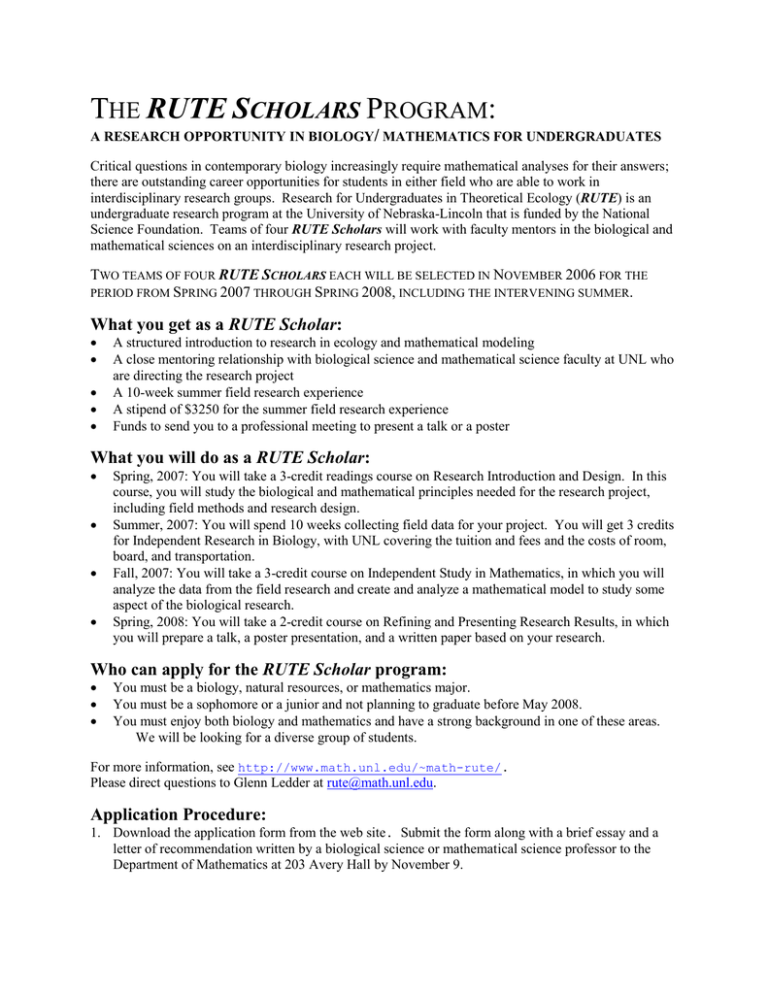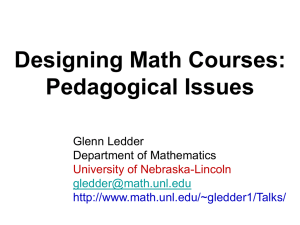2007 RUTE Program and Project Descriptions
advertisement

THE RUTE SCHOLARS PROGRAM: A RESEARCH OPPORTUNITY IN BIOLOGY/ MATHEMATICS FOR UNDERGRADUATES Critical questions in contemporary biology increasingly require mathematical analyses for their answers; there are outstanding career opportunities for students in either field who are able to work in interdisciplinary research groups. Research for Undergraduates in Theoretical Ecology (RUTE) is an undergraduate research program at the University of Nebraska-Lincoln that is funded by the National Science Foundation. Teams of four RUTE Scholars will work with faculty mentors in the biological and mathematical sciences on an interdisciplinary research project. TWO TEAMS OF FOUR RUTE SCHOLARS EACH WILL BE SELECTED IN NOVEMBER 2006 FOR THE PERIOD FROM SPRING 2007 THROUGH SPRING 2008, INCLUDING THE INTERVENING SUMMER. What you get as a RUTE Scholar: A structured introduction to research in ecology and mathematical modeling A close mentoring relationship with biological science and mathematical science faculty at UNL who are directing the research project A 10-week summer field research experience A stipend of $3250 for the summer field research experience Funds to send you to a professional meeting to present a talk or a poster What you will do as a RUTE Scholar: Spring, 2007: You will take a 3-credit readings course on Research Introduction and Design. In this course, you will study the biological and mathematical principles needed for the research project, including field methods and research design. Summer, 2007: You will spend 10 weeks collecting field data for your project. You will get 3 credits for Independent Research in Biology, with UNL covering the tuition and fees and the costs of room, board, and transportation. Fall, 2007: You will take a 3-credit course on Independent Study in Mathematics, in which you will analyze the data from the field research and create and analyze a mathematical model to study some aspect of the biological research. Spring, 2008: You will take a 2-credit course on Refining and Presenting Research Results, in which you will prepare a talk, a poster presentation, and a written paper based on your research. Who can apply for the RUTE Scholar program: You must be a biology, natural resources, or mathematics major. You must be a sophomore or a junior and not planning to graduate before May 2008. You must enjoy both biology and mathematics and have a strong background in one of these areas. We will be looking for a diverse group of students. For more information, see http://www.math.unl.edu/~math-rute/. Please direct questions to Glenn Ledder at rute@math.unl.edu. Application Procedure: 1. Download the application form from the web site. Submit the form along with a brief essay and a letter of recommendation written by a biological science or mathematical science professor to the Department of Mathematics at 203 Avery Hall by November 9. RUTE Projects for 2007-2008: 1. Characterizing the Population Dynamics of Duckweed in Natural Settings What are the major forces limiting the population abundance of duckweed (Lemna) in natural settings? A major goal of this project will be to describe the dynamics of natural populations. A few locations (probably in and around Cedar Point) will be identified which can easily and regularly be visited. Census techniques need to be developed which can be scaled to track both sparse and dense locations. These techniques will be used to create regular population counts in order to track population dynamics across the season. Observations on natural competitors, herbivores, and diseases of the duckweed populations will also be recorded and may lead to some short-duration experiments. Data collected on these populations will be used to generate mathematical models which are consistent with the observed time series and may test ideas inspired by natural history observations made by the student participants. The field work will be led by Dr. Chad Brassil, a population ecologist in the School of Biological Sciences. Dr. Brassil is keenly interested in developing the duckweed system as a model system which can be used to gain insight into population dynamics broadly. The mathematical work will be led by Dr. Irakli Loladze, a mathematical biologist in the Department of Mathematics. Dr. Loladze is particularly interested in the affects of chemical stoichiometry on animal and plant growth and population dynamics. 2. West Nile Virus and vector population biology: predicting the next big outbreak West Nile Virus reached Nebraska in 2003; 29 people died of the disease and over 2000 contracted the virus. Since then the disease has never reached similar proportions. Under what conditions could an outbreak similar to 2003 arise? Is it driven by weather, population dynamics of the host, population dynamics of the vector, or a combination of all three? In this project we will focus on the dynamics of the vector population early in the season prior to WNV emergence in statewide surveillance programs - the virus must be present but has not been studied in sufficient detail to understand this critical early phase. Previous work has focused on ecosystems in the eastern half of North America, but the suite of vector mosquitos found in Nebraska is different and this could alter the dynamics of the disease. Is it possible to predict the magnitude of the WNV season at an early stage? The field and laboratory work will be based in Lincoln. Field and laboratory work will be led by Dr. Drew Tyre, a population ecologist with the School of Natural Resources. Dr. Tyre works on bird, insect, parasite and disease dynamics in a variety of ecosystems. The mathematical work will be led by Dr. Glenn Ledder, a mathematical modeler in the Department of Mathematics. Dr. Ledder is particularly interested in development and characterization of mathematical models that combine population dynamics with epidemiology.



